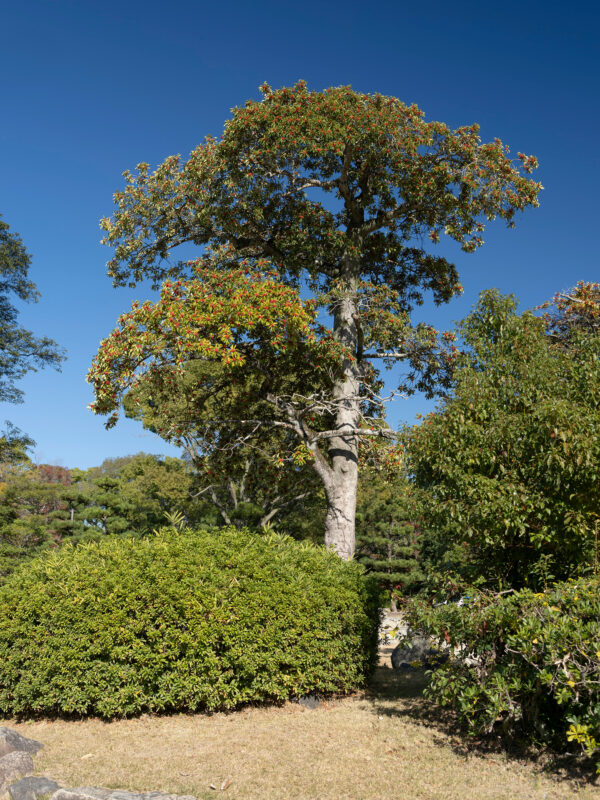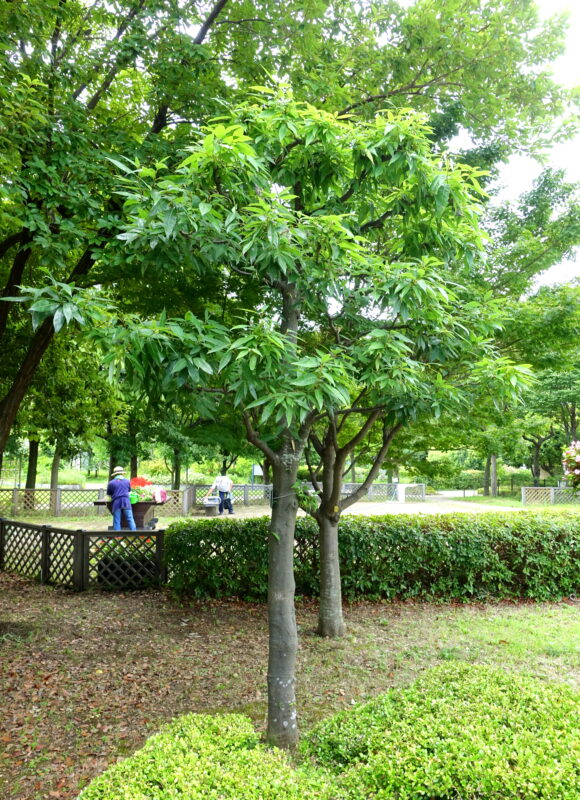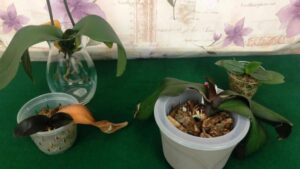Below, we’ll explore some notable species of Japanese evergreens, each rich with unique characteristics and histories.
Buxus microphylla var. japonica (Japanese Box; Tsuge)
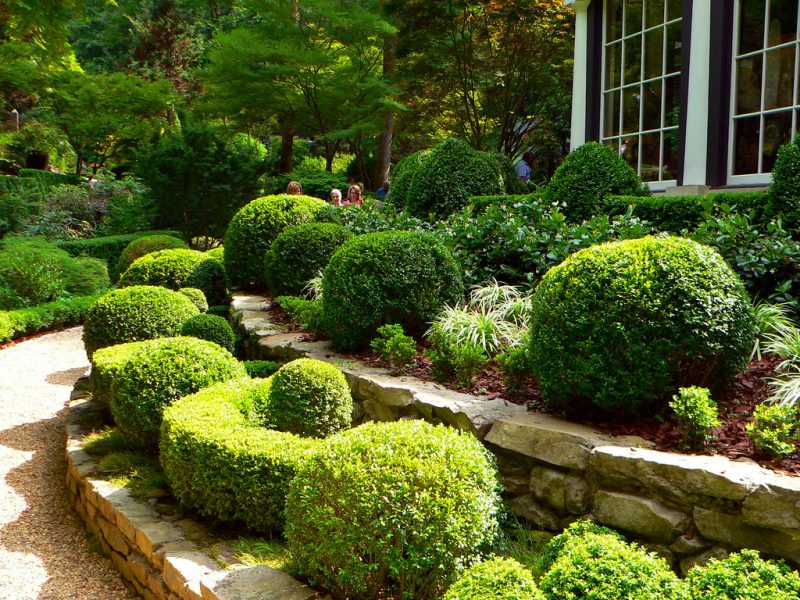
The Japanese Box, or Tsuge, is a popular choice for both traditional and modern gardens. Recognized for its dense, compact growth, Buxus microphylla var. japonica is revered for its versatility as a low hedge or a feature plant. This evergreen shrub grows steadily to a height of about 3–5 feet and boasts tiny, glossy leaves that remain vibrant throughout the year.
One of the defining characteristics of Tsuge is its ability to adapt to various soil types and conditions, showing resilience in both shaded and sunny areas. Its density makes it an excellent choice for bonsai cultivation, and it often features in Japanese-style gardens, where it can be shaped to form intricate topiaries and borders.
In Japanese culture, Buxus microphylla var. japonica symbolizes longevity and perseverance. It’s a favorite for its elegance, as well as its role in enhancing the containment and formality of a garden space. Homeowners seeking sustainability find this plant’s low maintenance appealing, allowing them to enjoy the beauty of their gardens with minimal effort.
Cleyera japonica (Sakaki)
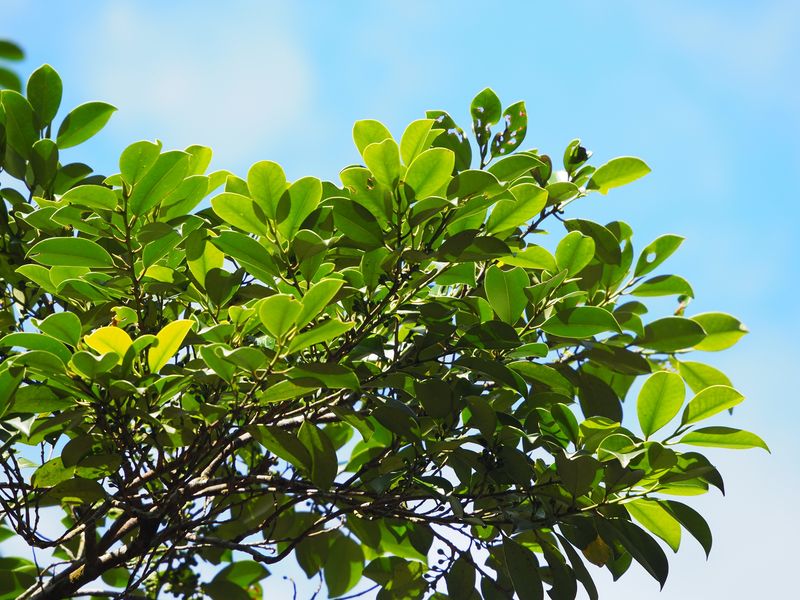
Cleyera japonica, commonly known as Sakaki, is a majestic evergreen that graces Japanese landscapes with its lush foliage and smooth, attractive bark. Native to Japan, this shrub grows to heights of 3 to 10 feet, making it perfect for privacy hedges or specimen plantings. Its dark green leaves are distinctive, glossy, and leathery, creating a subtle shimmer that enhances the garden’s aesthetic.
Sakaki holds profound cultural significance in Shintoism, where it is associated with divine energy and purity. Traditionally, its branches are used in sacred rituals and are often placed at shrines. Beyond its spiritual symbolism, Cleyera japonica provides excellent habitat for birds and other wildlife, making it an ecologically beneficial choice.
This evergreen is relatively easy to cultivate but prefers well-drained soil and a bit of shade to flourish. It’s important to prune Sakaki regularly to maintain its shape and encourage a bushy growth habit. Its adaptability to urban environments has made it a popular choice in landscaping, where it provides year-round greenery against the concrete backdrop.
Daphniphyllum macropodum
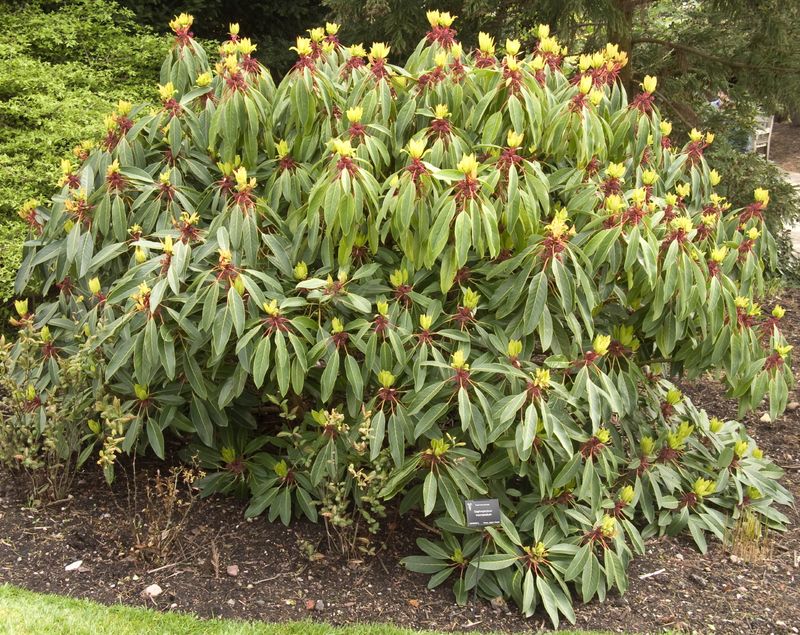
Daphniphyllum macropodum, often referred to as the Big-footed Daphniphyllum, adds a unique and exotic touch to Japanese gardens. With leaves that can reach impressive lengths of up to 12 inches, it captures attention with its bold foliage. Native to the mountainous regions of Japan, this evergreen prefers a shady habitat, thriving in moist, well-drained soil that mimics its natural environment.
A truly resilient plant, Daphniphyllum macropodum is notable for its ability to withstand the rigors of unpredictable weather, from heavy rains to dry spells. Its leaves are not only visually striking but also possess a waxy coating that helps retain moisture, ensuring they look lush even in challenging environments.
Culturally, Daphniphyllum has associations with longevity and endurance, often used in garden designs that aim to evoke a sense of tranquility and permanence. For gardeners who appreciate rare finds, this evergreen serves not only as an eye-catching specimen but also as a conversation starter, emphasizing the extraordinary diversity of Japanese flora.
Dendropanax trifidus (Kakure-mino)
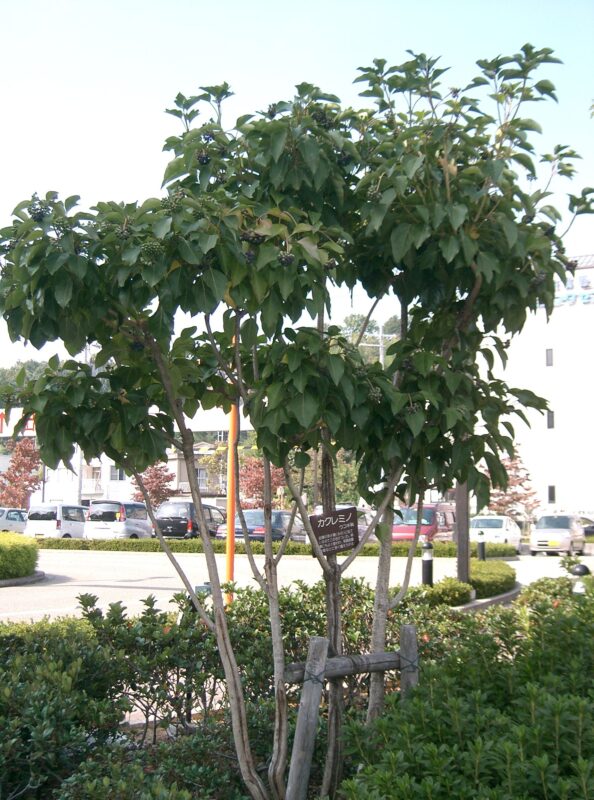
Dendropanax trifidus, known as Kakure-mino, is a unique evergreen characterized by its conspicuous leaves that can resemble a hand with fingers spread. This shrub is native to the subtropical forests of Japan and can grow up to 20 feet tall, making it suitable as both an understorey plant and a standout specimen.
The distinctive leaf shape serves as a key identifier, with glossy green foliage exhibiting a versatile growth habit. Kakure-mino thrives in well-drained, organic-rich soils and prefers light shade, making it a fantastic choice for woodland gardens or shade borders. Its versatility allows it to adapt well across various climatic conditions, from coastal settings to cooler, mountainous regions.
Kakure-mino is appreciated for its striking appearance, though it also fulfills ecological roles, providing shelter and food for various bird species. In many gardens, these plants symbolize protection and comfort, as their thick foliage provides a cozy refuge in bustling environments.
Ilex crenata (Box-Leaved Holly/Japanese Holly; Inu-Tsuge)

Ilex crenata, commonly referred to as Box-Leaved Holly or Inu-Tsuge, is a quintessential component of many Japanese gardens. This evergreen shrub boasts small, glossy leaves resembling those of the traditional boxwood, making it suitable for hedging and topiary. Ranging from 3 to 15 feet in height, Ilex crenata demonstrates adaptability to various soil types and can thrive in both full sun and partial shade.
The decorative aspect of this holly is further enhanced by its winter hardiness and its ability to withstand pruning, allowing for creative topiary forms. Ilex crenata produces small black berries that attract birds, adding an additional layer of ecological importance to its aesthetic beauty.
In Japanese culture, this plant symbolizes loyalty and honesty. Gardeners appreciate its resilience and low maintenance needs, making it a popular choice for homeowners who value an evergreen with year-round allure. Overall, Ilex crenata serves as a timeless staple in many landscape designs, combining functional beauty with cultural significance.
Ilex integra (Mochi-no-Ki)
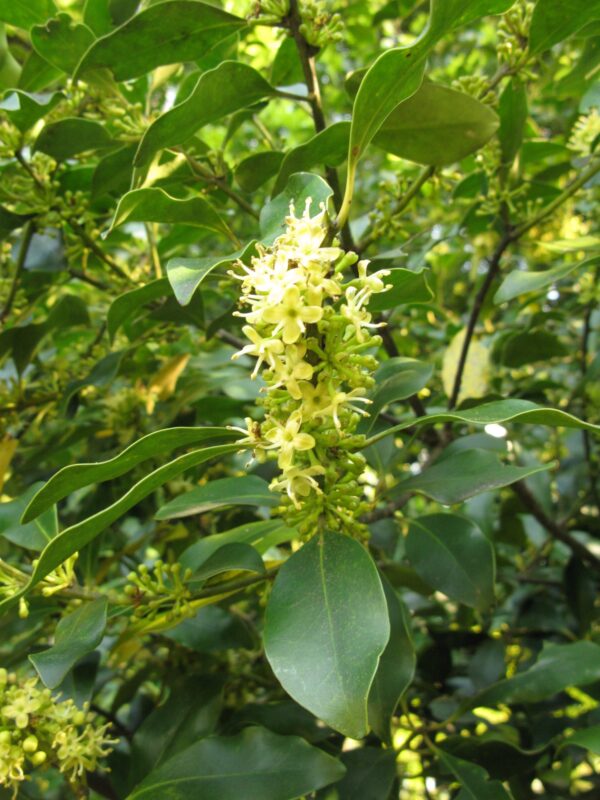
Ilex integra, or Mochi-no-Ki, is another holly species that shines in Japanese gardens. This evergreen shrub can grow up to 20 feet tall, showcasing thick, lustrous leaves that are darker green than many of its relatives. The name Mochi-no-Ki translates to “tree of rice cake,” reflecting its cultural connection; traditionally, the leaves were used to wrap the sweet rice cakes known as “mochi.”
Mochi-no-Ki thrives best in well-drained soils and can tolerate a range of light conditions, although it prefers partial shade. Its striking foliage is not the only draw; in late summer, Ilex integra produces clusters of small, white flowers that attract pollinators, contributing to the biodiversity of the garden.
This evergreen embodies resilience and adaptability, often chosen for urban landscapes due to its ability to withstand pollution and adverse weather. The symbolic use of Ilex integra in Japanese culture highlights the harmony between human activity and nature, making it a beloved choice in contemporary landscaping endeavors.
Ilex latifolia (Luster-Leaf Holly; Tarayo)
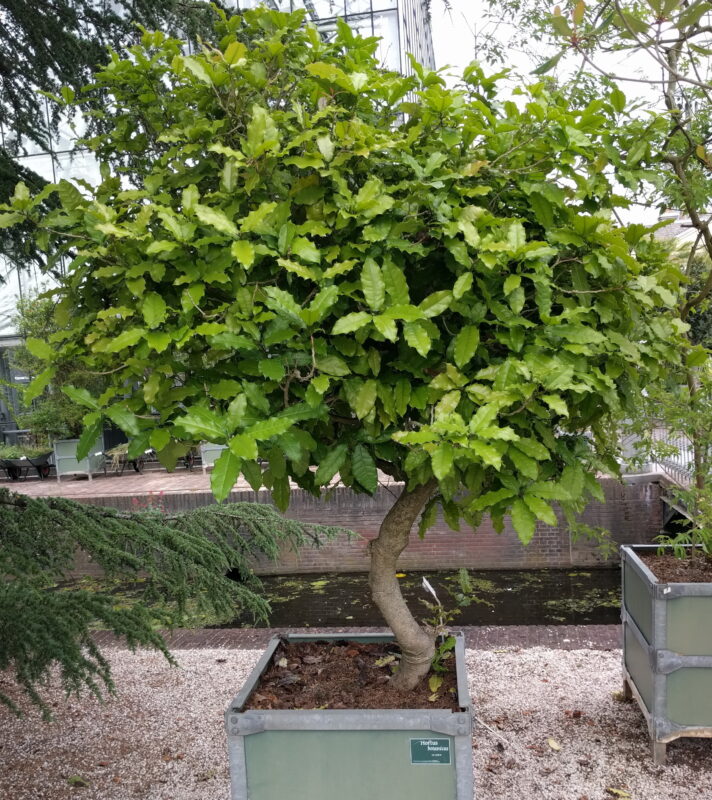
Ilex latifolia, or Luster-Leaf Holly, is an exceptional evergreen noted for its broad, glossy leaves that radiate a rich green hue. Typically found in the coastal regions of Japan, this holly can grow 10 to 30 feet tall, making it a striking element for any garden or landscape.
One of the standout features of Luster-Leaf Holly is its ability to thrive in a variety of conditions, including salt-laden winds, which make it a popular option for coastal gardens. Beyond its ornamental appeal, Ilex latifolia also produces small, red berries that are not only visually appealing but also provide sustenance for birds in the winter months.
In Japanese philosophy, this plant represents endurance and resilience, often integrated into gardens designed to evoke a rich interaction between the built environment and the natural world. Enthusiasts appreciate that Luster-Leaf Holly can be pruned for texture or left to grow naturally, allowing for diverse landscape applications.
Ilex pedunculosa (Long-Stalk Holly; Soyogo)

Ilex pedunculosa, known commonly as Long-Stalk Holly or Soyogo, captures the eye with its distinctive drooping fruit and slender stems. This evergreen shrub typically grows 6 to 10 feet tall, making it an elegant choice for borders or stand-alone specimens.
The long-stemmed berries of Ilex pedunculosa add unique visual interest as they hang elegantly from the branches. This holly thrives in acidic, well-draining soils and can be found in both sun and shaded areas. Its relatively easy cultivation makes it a favorite among gardeners who are looking for manageable landscaping options.
In Japanese culture, Ilex pedunculosa symbolizes protection and fortitude. Homeowners often choose this evergreen for its fruit’s aesthetic appeal and its usefulness in attracting birds. Its adaptable nature and striking presentation contribute to its prominence in various garden styles.
Ilex rotunda (Kurogane Holly/Round-Leaf Holly; Kurogane-Mochi)
Ilex rotunda, commonly referred to as Kurogane Holly or Round-Leaf Holly, stands out for its thick, rounded leaves that lend a unique texture and color to the landscape. This evergreen can grow to heights between 10 to 15 feet, making it a perfect choice for creating natural screens or hedges.
This species features small white flowers that bloom in spring, followed by bright red berries that provide food for wildlife through the colder months. Ideal for moist, well-drained soils, Kurogane Holly is an excellent candidate for creating lush, green spaces, particularly in areas that experience more humid conditions.
In Japanese horticulture, Ilex rotunda embodies strength and wellbeing, often utilized in gardens meant to promote tranquility and relaxation. The dense foliage not only offers privacy but also contributes to the overall ecological health of the garden by supporting local fauna.
Lithocarpus edulis (Japanese Stone Oak; Mate-Bashii)
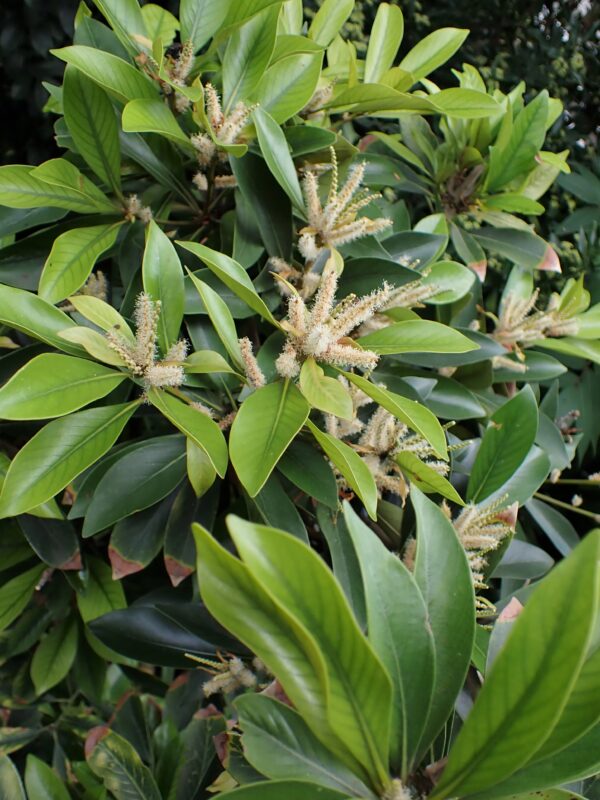
Lithocarpus edulis, known as Japanese Stone Oak or Mate-Bashii, is an extraordinary evergreen tree that can reach heights of 50 feet or more. This towering presence adds grandeur to any landscape, featuring thick, leathery leaves that have a rich, dark green hue.
The acorns from the Japanese Stone Oak are edible and traditionally used in various culinary practices, highlighting the species’ cultural significance. The tree thrives best in well-drained, fertile soils and can adapt to shaded or sunny locations.
Lithocarpus edulis symbolizes resilience and strength, often incorporated into garden designs that emphasize permanence. Many gardeners appreciate its majestic silhouette and the enriching biodiversity it fosters, as it supports numerous species of insects and birds, making it a pillar of ecological health in any landscape.
Pittosporum tobira (Japanese Mock Orange; Toberi)
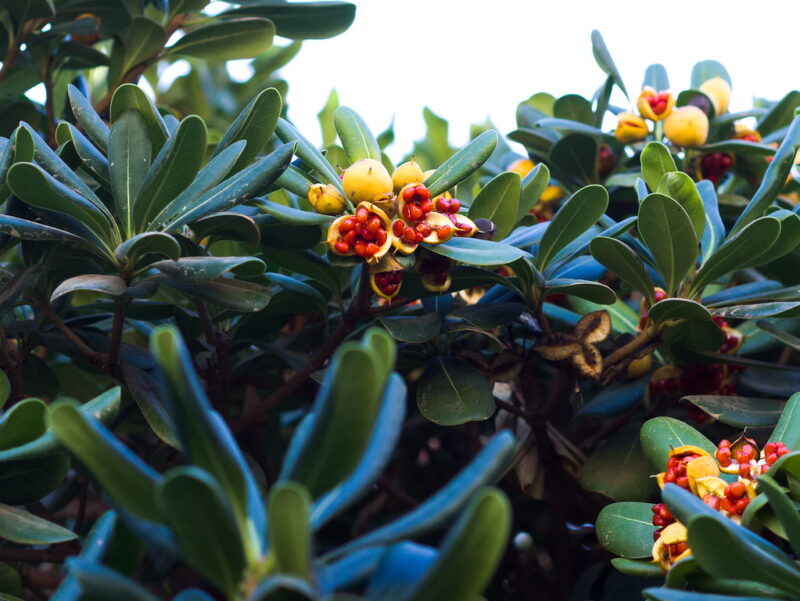
Pittosporum tobira, commonly known as Japanese Mock Orange or Toberi, enchants with its fragrant, creamy-white flowers that appear in early summer. This evergreen shrub typically grows between 6 and 12 feet tall and features narrow, glossy leaves that provide year-round beauty.
Native to Japan, Toberi thrives in well-drained soils and can tolerate a variety of light conditions, from full sun to partial shade. Its multiple uses—serving as a hedge, foundation plant, or accent piece—make it a versatile choice for gardeners looking to create captivating landscapes.
Culturally, the scented flowers of Pittosporum tobira symbolize appreciation and gratitude. Gardener’s love incorporating this evergreen not only for its beauty and fragrance but also for its ability to attract pollinators, enhancing the overall health and diversity of their gardens.
Osmanthus x fortunei (Fortune’s Osmanthus; Hiiragi-Mokusei)
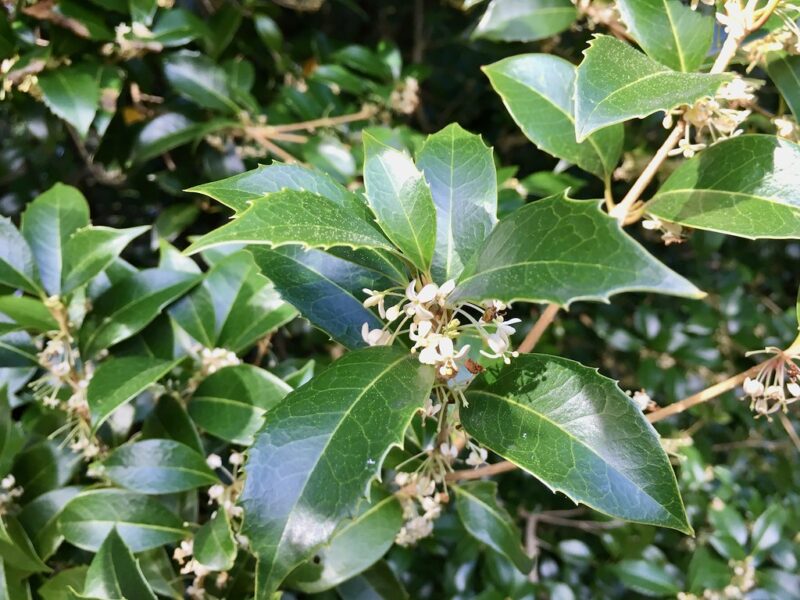
Osmanthus x fortunei, or Fortune’s Osmanthus, is an alluring evergreen shrub renowned for its sweetly aromatic flowers. Growing up to 15 feet tall, this hybrid osmanthus is prized for both its ornamental qualities and highly fragrant blossoms, which typically appear in the fall.
The glossy, leathery leaves of Fortune’s Osmanthus present an attractive dark green backdrop, making it a stunning feature in any garden. This plant thrives in well-drained soils and prefers sunny to partially shaded environments, allowing it flexibility in landscape design.
In Japanese culture, Osmanthus symbolizes love and fidelity, positioning it as a popular choice for gardens intended for relaxation and romantic ambiance. Gardeners adore this plant not only for its delightful fragrance but also because the blooms attract beneficial insects, contributing to a balanced ecosystem.
Osmanthus heterophyllus (Holly Osmanthus; Hiiragi)

Osmanthus heterophyllus, known as Holly Osmanthus or Hiiragi, is another fragrant evergreen that captures the senses with its sweet-smelling flowers. This shrub can grow between 6 and 15 feet tall, showcasing attractive, holly-like leaves that lend a unique texture to the garden.
The early autumn blooms of Holly Osmanthus produce a delightful fragrance that evokes memories of warm, traditional festivities. This evergreen shrub is adaptable, thriving in various soils, and prefers partially shaded habitats.
In the realm of Japanese aesthetics, Osmanthus heterophyllus symbolizes loyalty and devotion, making it a suitable choice for gardens designed with intention and care. Its longevity and resilience add to its charm, making it a treasured component in many Japanese landscapes.
Quercus glauca (Ring-Cup Oak; Ara-Kashi)
Quercus glauca, commonly called Ring-Cup Oak or Ara-Kashi, is a towering evergreen tree that can reach heights of up to 30 feet. This majestic oak features unique, blue-green leaves that provide remarkable contrast in the landscape, making it a sought-after focal point.
The Ring-Cup Oak thrives in well-drained soils and sunlit areas, establishing itself as a significant presence in both forested and garden settings. Its acorns, though modest in size, attract wildlife, enriching the ecosystem of the garden.
In Japanese culture, Quercus glauca symbolizes strength and protection, which leads many gardeners to incorporate this significant species into landscapes designed for longevity. Its robust stature and ability to survive in a variety of conditions make it a reliable addition to any garden portfolio.
Quercus myrsinifolia (Bamboo-Leaf Oak/Chinese Evergreen Oak)
Quercus myrsinifolia, also known as Bamboo-Leaf Oak, is notable for its slender, elongated leaves resembling those of bamboo. This evergreen oak typically grows between 30 and 60 feet tall and has a beautiful, rounded crown that adds substantial shade and grandeur to the landscape.
The bird-friendly characteristics of this tree make it a valuable choice for ecologically minded gardeners. It thrives best in well-drained soils and can tolerate a wide range of climatic conditions, presenting versatility and resilience in various garden designs.
Symbolically, Quercus myrsinifolia reflects flexibility and adaptability, emphasizing the natural ease with which it integrates into diverse landscapes. Its lush foliage not only beautifies gardens but also facilitates a robust eco-ecosystem, making it a cherished component of Japanese flora.
Quercus phillyraeoides (Ubame-Gashi)

Quercus phillyraeoides, commonly known as Ubame-Gashi, is a smaller evergreen oak that typically reaches height of 20 to 30 feet. This species is particularly valued for its compact size, making it a preferred choice for smaller gardens or urban installations.
Characterized by its leathery leaves and dense canopy, Ubame-Gashi provides excellent shade and has a unique charm. This evergreen flourishes in well-drained, acidic soils, often found in regions facing winds and challenging weather conditions.
In Japanese culture, Quercus phillyraeoides symbolizes determination and hard work, often employed in gardens that foster a sense of purpose and beauty. Its compact nature makes it accessible for various landscape designs, while its ecological contributions nourish local wildlife.
Ternstroemia gymnanthera (Mokkoku)
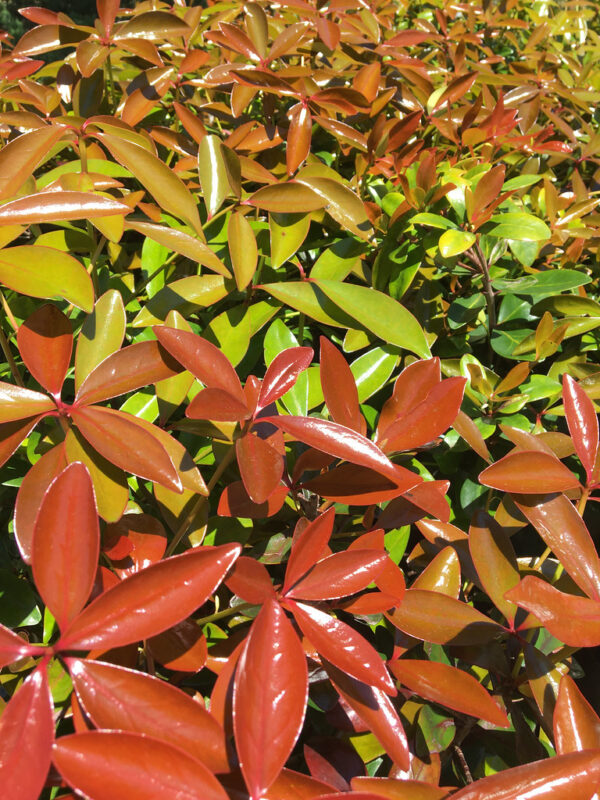
Ternstroemia gymnanthera, commonly known as Mokkoku, is a small evergreen tree that brings a unique twist to any garden. This plant features elliptical leaves and can reach heights of 15 to 25 feet, showcasing lovely, glossy foliage.
Mokkoku has an interesting growth habit, often branching out to create a dense crown that provides warmth and structure in garden settings. It requires well-drained, slightly acidic soils and thrives in partial shade, making it an intriguing option for woodland gardens.
Culturally, Ternstroemia gymnanthera symbolizes preservation and continuity, making it a fitting choice in landscapes aimed at fostering harmony and connection with nature. Its adaptability and attractive presentation create opportunities for creative landscaping, making it a favored choice among garden enthusiasts.



